A Practitioner Explains the Uses of Patent Prosecution Analytics

wpengine
September 22, 2022
A common criticism I hear about patent prosecution analytics is that the data is not fully informative or doesn’t show you the complete picture. Even though analytics may not seem helpful for every case, my experience is that, over time, they will give patent attorneys an edge and improve results for their clients overall.
Much like sports data, patent prosecution analytics may not guarantee a win but will provide a scouting report for facing challenging opposition.
Using examiner stats to improve patent prosecution performance
Before examiner statistics were available, patent attorneys, like me, often felt we were working blind without insight into what type of examiner we were assigned. Did the examiner have heightened standards of unpatentability, or did the examiner simply want the claims to be more precise? It often took rounds of rejections to figure out an examiner’s tendencies. Data helps to remove this ambiguity and provides insight enabling attorneys to prepare and set expectations for the challenges ahead of them.
I continually tap into multiple examiner statistics provided by patent prosecution analytics, including:
- Examiner interview data—This compares an examiner’s allowance rate (AR) with and without an interview. It allows a prosecutor to quickly decide if scheduling an interview seems to be the next right move or is likely to be a waste of a client’s money. Often, but not always, getting an examiner on the phone is the best strategy to speed up the process.
- Office Actions per patent—This is the average number of Office Actions (OAs) an examiner issues per granted patent. This information helps prosecutors decide whether to file an appeal or respond to the OA based on the average number for that particular examiner. It helps save clients considerable money by avoiding filing multiple Requests for Continued Examination (RCE) in case the examiner has a high OA per patent and appears to be dragging out prosecution.
- Examiner allowance rate vs. Art Unit allowance rate—An examiner with a low AR who operates in an Art Unit with a high AR is usually a difficult examiner. The LexisNexis PatentAdvisor® system has gone a step further to make examiner behavior prediction more reliable with the proprietary metric PatentAdvisor Examiner Time Allowance (or PatentAdvisor ETA™).
- Appeal statistics—Before examiner statistics were available, if an examiner seemed unreasonable, the attorney had to manually go through individual Patent Trial and Appeal Board (PTAB) decisions to figure out if the examiner was frequently reversed on appeal. Thanks to solutions like PatentAdvisor™, attorneys can look at examiner analytics to easily determine an examiner’s appeal metrics. Is the examiner frequently reversed on appeal? Does the examiner allow an application in response to the filing of a pre-appeal conference request or appeal brief? Does the examiner always reopen prosecution in response to an appeal being filed? This is important information that helps set expectations for clients. Also, one can easily find appeal decisions using the PTAB decisions tool, which includes 111,000 PTAB decisions that have been tagged for specific arguments.
Using client analytics to start conversations on strategy
Assignee analytics in PatentAdvisor show patent prosecution statistics on a company level. When starting discussions about strategy, simply looking at the organization’s average AR, total number of applications, OAs per patent, interview statistics, etc., can help to initiate insightful conversations with clients on their existing strategy.
From my experience, many clients find such analytics useful for further discussions, which can help to audit procedures that are currently in place. OA statistics for a company, like those shown below, also help to analyze the prosecution strategy that a company has been following in the past.
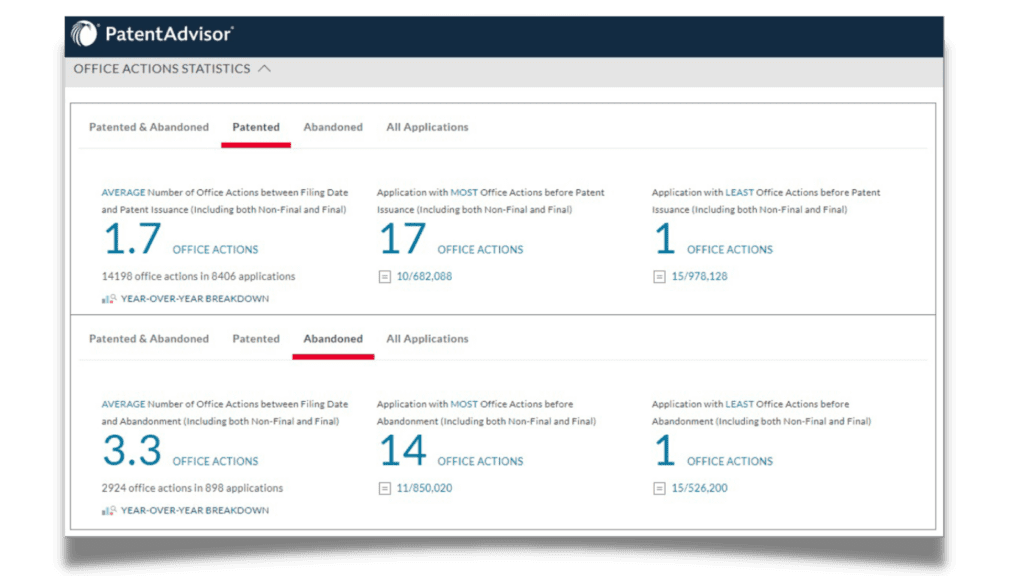
Clients also like the comparative analytics provided by patent prosecution data because it gives context to their metrics in comparison to the metrics of their competitors. It answers questions for them like: are they filing enough applications, do they need to take steps to improve efficiency, “are they not appealing enough? etc.
Another added advantage for corporate clients is that analytics can make it easier for in-house attorneys to communicate with board and management teams. Analytics can help to illustrate the effectiveness of their current patent strategy to people who may not be necessarily IP-savvy.
Example of Apple vs. Samsung
It is interesting to look at two of the most prominent players in the technology space through the lens of patent prosecution analytics. In the example of Apple vs. Samsung, it is clear from the chart below that Samsung is filing many more applications than Apple, but Apple has a better AR.
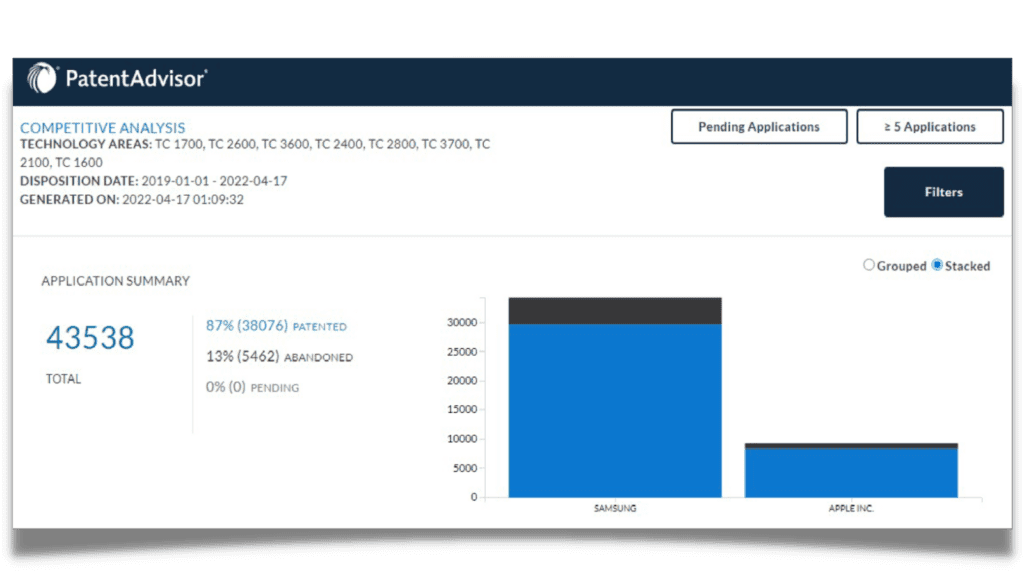
The chart below shows Effectiveness vs. Efficiency. Apple has about a 4% higher efficiency score as calculated by PatentAdvisor. This metric eliminates the noise within the data created by patent examiner variability, which influences the outcome of an application, to provide more normalized data that allows for a more transparent comparison of prosecution efficiency.
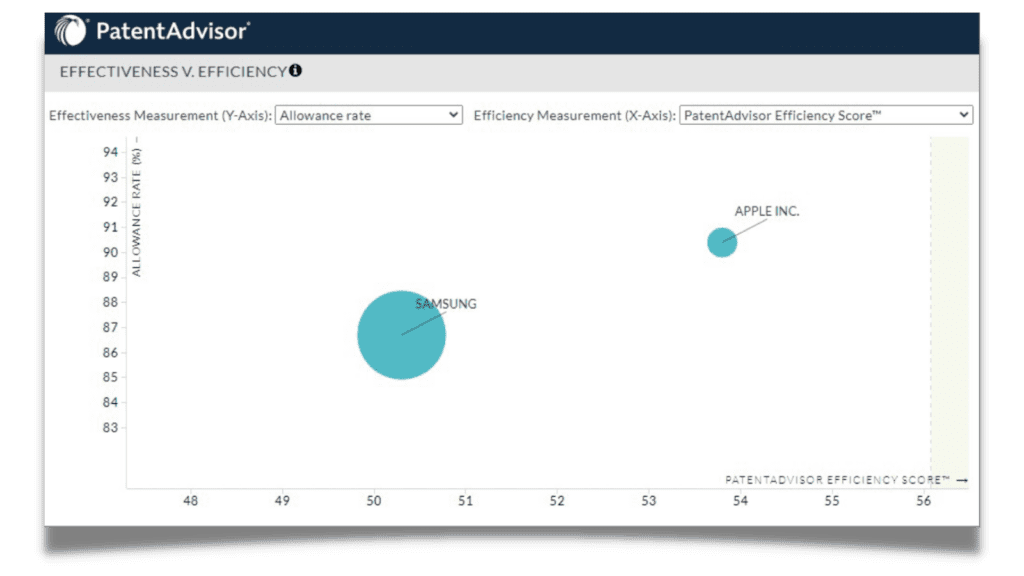
Apple and Samsung’s strategies seem pretty effective overall when looking at the average number of OAs to issuance.
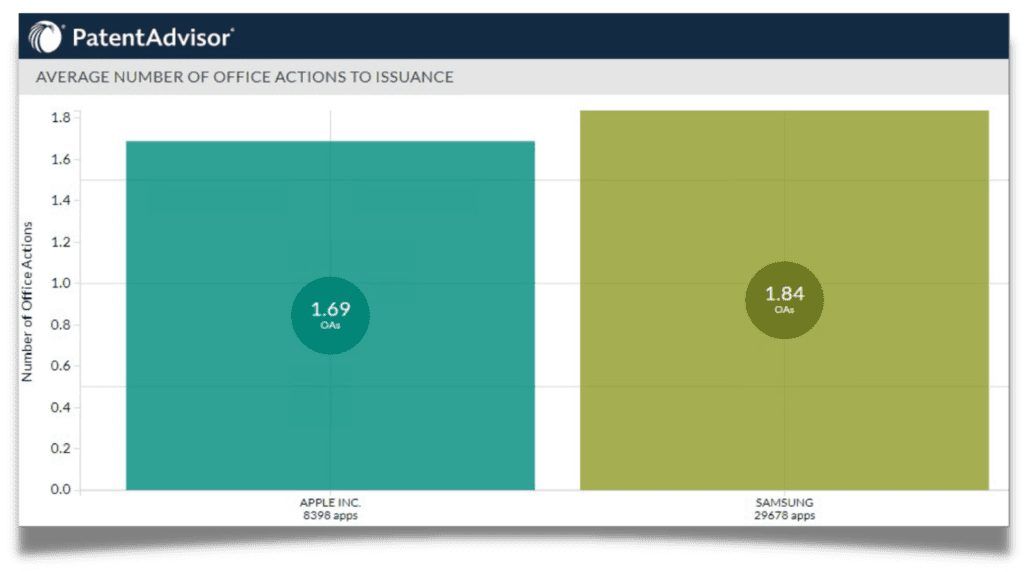
There is a stark difference between the strategies of the two companies in the example observed in the following chart. Apple is appealing a higher percentage of rejections than Samsung. To me, this is an important indicator of claims scope; appealing infrequently could mean a loss of claims scope that might prove to be important much later. An attorney for Samsung looking at this data could recommend increased appealing as a strategy to consider.
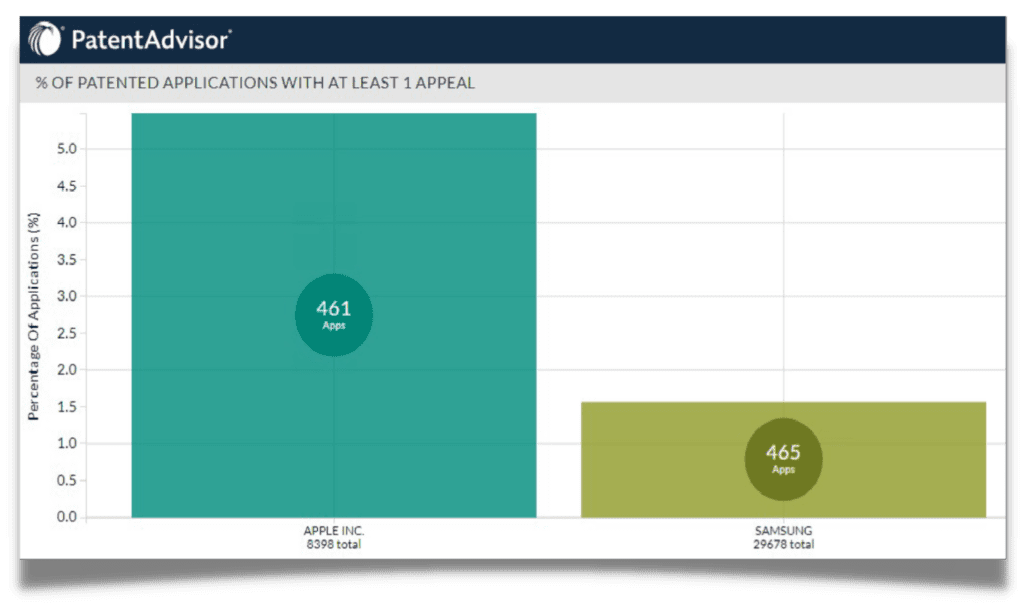
Data and analytics—The future of patent prosecution
More and more patent attorneys, like myself, are feeling pressure from clients to prove efficiency and evolve into strategic business partners. Moving away from the idea of being a cost center, proving your value to your firm and to clients and showing how you can help speed up the process of innovation are all key tasks. In my opinion, patent prosecution data and analytics are not yet as useful as they could be, but they will continue to evolve so every patent attorney should be developing a knowledge base. I find patent analytics to be an invaluable tool in my arsenal, as I am always looking to improve and find every advantage possible.
If you are interested in discussing analytics or want to read more, check out my blog phositb.com, or find me on LinkedIn. I frequently post about how analytics can guide prosecution to gain every possible advantage.
About the Author:
Clint Mehall is a registered patent attorney practicing in multiple technology areas. Mr. Mehall has prosecuted hundreds of U.S. patent applications from filing to issuance, taking into consideration patent analytics for efficient prosecution without unnecessarily narrowing the claims. During prosecution, Mr. Mehall has an aptitude for identifying when a patent examiner will not issue claims of a reasonable scope, and has filed over a hundred appeals with the USPTO PTAB, where he has an exceptional win rate. Representative technologies of his practice include: electric vehicle batteries, metallurgy, nuclear energy, aeronautics, image processing, automated controls systems, automotive drivetrains, rail transport, semiconductors, wireless data transmission systems, fuel cells, various software, nonwoven fabrics, convertible vehicle tops and printing presses.
Mr. Mehall also has experience collaborating with foreign attorneys on patent applications in Europe, Japan and China, litigating patents, post-grant proceedings and client counseling, which includes performing patentability searches, and preparing infringement, validity and freedom to operate opinions. Currently, he serves as the co-chair of NYIPLA’s Patent Law & Practice Committee. Mr. Mehall graduated Cum Laude from DePaul University College of Law in May 2007. At DePaul, he was an associate editor for DePaul’s Intellectual Property Digest, counseled clients through DePaul’s Intellectual Property/Technology Clinic and was a semifinalist in DePaul’s New Venture Business Challenge. He was admitted to practice law in New York in February 2008 and was admitted to practice before the USPTO in May 2008. Mr. Mehall received a Bachelor of Science in biological engineering, with a biomedical emphasis, from the University of Missouri-Columbia in 2003.

Need more predictability in the patent prosecution process?
Learn how to develop successful IP strategies and proficiently manage patent applications throughout the entire prosecution process using data-driven insights and advanced analytics.
